翻译讲座二说课讲解
- 格式:ppt
- 大小:140.50 KB
- 文档页数:8
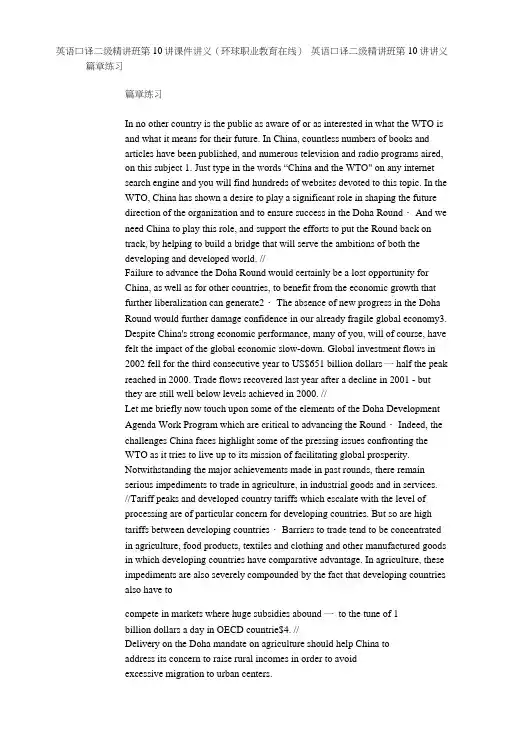
英语口译二级精讲班第10讲课件讲义(环球职业教育在线)英语口译二级精讲班第10讲讲义篇章练习篇章练习In no other country is the public as aware of or as interested in what the WTO isand what it means for their future. In China, countless numbers of books andarticles have been published, and numerous television and radio programs aired,on this subject 1. Just type in the words “China and the WTO" on any internetsearch engine and you will find hundreds of websites devoted to this topic. In theWTO, China has shown a desire to play a significant role in shaping the futuredirection of the organization and to ensure success in the Doha Round・ And weneed China to play this role, and support the efforts to put the Round back ontrack, by helping to build a bridge that will serve the ambitions of both thedeveloping and developed world. //Failure to advance the Doha Round would certainly be a lost opportunity forChina, as well as for other countries, to benefit from the economic growth thatfurther liberalization can generate2・ The absence of new progress in the DohaRound would further damage confidence in our already fragile global economy3.Despite China's strong economic performance, many of you, will of course, havefelt the impact of the global economic slow-down. Global investment flows in2002 fell for the third consecutive year to US$651 billion dollars一half the peakreached in 2000. Trade flows recovered last year after a decline in 2001 - butthey are still well below levels achieved in 2000. //Let me briefly now touch upon some of the elements of the Doha DevelopmentAgenda Work Program which are critical to advancing the Round・ Indeed, thechallenges China faces highlight some of the pressing issues confronting theWTO as it tries to live up to its mission of facilitating global prosperity.Notwithstanding the major achievements made in past rounds, there remainserious impediments to trade in agriculture, in industrial goods and in services.//Tariff peaks and developed country tariffs which escalate with the level ofprocessing are of particular concern for developing countries. But so are hightariffs between developing countries・ Barriers to trade tend to be concentratedin agriculture, food products, textiles and clothing and other manufactured goodsin which developing countries have comparative advantage. In agriculture, theseimpediments are also severely compounded by the fact that developing countriesalso have tocompete in markets where huge subsidies abound 一to the tune of 1billion dollars a day in OECD countrie$4. //Delivery on the Doha mandate on agriculture should help China toaddress its concern to raise rural incomes in order to avoidexcessive migration to urban centers.女士们、先生们,任何一个国家的公众对WTO本身和WTO对他们将来影响的认识和兴趣,都没有中国的公众这么高。
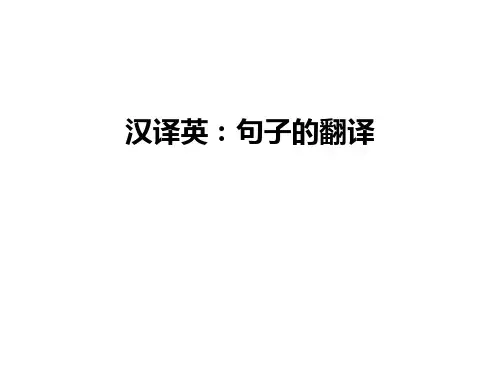
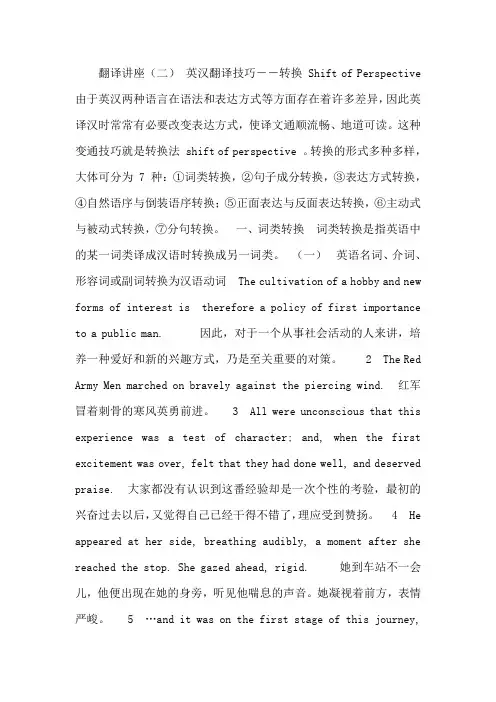
翻译讲座(二)英汉翻译技巧――转换 Shift of Perspective 由于英汉两种语言在语法和表达方式等方面存在着许多差异,因此英译汉时常常有必要改变表达方式,使译文通顺流畅、地道可读。
这种变通技巧就是转换法 shift of perspective 。
转换的形式多种多样,大体可分为 7 种:①词类转换,②句子成分转换,③表达方式转换,④自然语序与倒装语序转换;⑤正面表达与反面表达转换,⑥主动式与被动式转换,⑦分句转换。
一、词类转换词类转换是指英语中的某一词类译成汉语时转换成另一词类。
(一)英语名词、介词、形容词或副词转换为汉语动词 The cultivation of a hobby and new forms of interest is therefore a policy of first importanceto a public man. 因此,对于一个从事社会活动的人来讲,培养一种爱好和新的兴趣方式,乃是至关重要的对策。
2 The Red Army Men marched on bravely against the piercing wind. 红军冒着刺骨的寒风英勇前进。
3 All were unconscious that this experience was a test of character; and, when the first excitement was over, felt that they had done well, and deserved praise. 大家都没有认识到这番经验却是一次个性的考验,最初的兴奋过去以后,又觉得自己已经干得不错了,理应受到赞扬。
4 He appeared at her side, breathing audibly, a moment after she reached the stop. She gazed ahead, rigid. 她到车站不一会儿,他便出现在她的身旁,听见他喘息的声音。
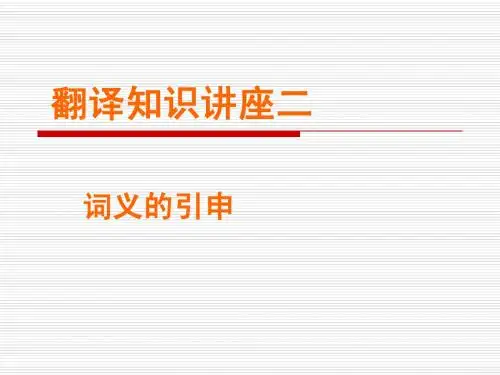
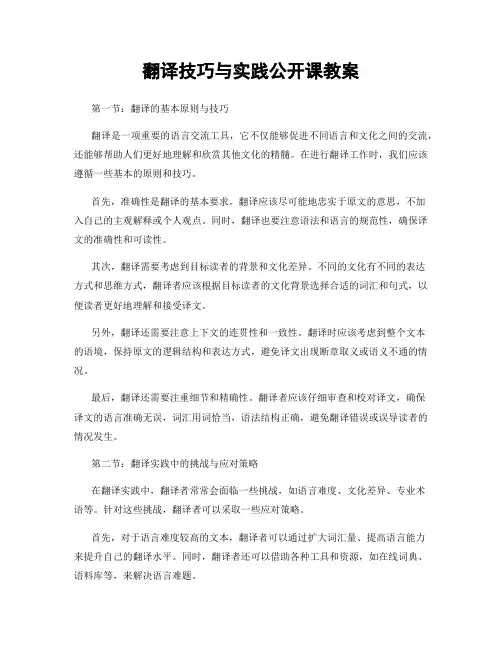
翻译技巧与实践公开课教案第一节:翻译的基本原则与技巧翻译是一项重要的语言交流工具,它不仅能够促进不同语言和文化之间的交流,还能够帮助人们更好地理解和欣赏其他文化的精髓。
在进行翻译工作时,我们应该遵循一些基本的原则和技巧。
首先,准确性是翻译的基本要求。
翻译应该尽可能地忠实于原文的意思,不加入自己的主观解释或个人观点。
同时,翻译也要注意语法和语言的规范性,确保译文的准确性和可读性。
其次,翻译需要考虑到目标读者的背景和文化差异。
不同的文化有不同的表达方式和思维方式,翻译者应该根据目标读者的文化背景选择合适的词汇和句式,以便读者更好地理解和接受译文。
另外,翻译还需要注意上下文的连贯性和一致性。
翻译时应该考虑到整个文本的语境,保持原文的逻辑结构和表达方式,避免译文出现断章取义或语义不通的情况。
最后,翻译还需要注重细节和精确性。
翻译者应该仔细审查和校对译文,确保译文的语言准确无误,词汇用词恰当,语法结构正确,避免翻译错误或误导读者的情况发生。
第二节:翻译实践中的挑战与应对策略在翻译实践中,翻译者常常会面临一些挑战,如语言难度、文化差异、专业术语等。
针对这些挑战,翻译者可以采取一些应对策略。
首先,对于语言难度较高的文本,翻译者可以通过扩大词汇量、提高语言能力来提升自己的翻译水平。
同时,翻译者还可以借助各种工具和资源,如在线词典、语料库等,来解决语言难题。
其次,文化差异也是翻译中的一大挑战。
翻译者应该具备跨文化交际的能力,了解不同文化的特点和习惯,以便更好地进行翻译工作。
在翻译过程中,翻译者可以采用文化适应和文化转换的策略,将原文的文化内涵转化为目标文化能够理解和接受的形式。
另外,专业术语的翻译也是翻译实践中的难点之一。
翻译者应该具备丰富的专业知识和术语库,以便准确地翻译专业术语。
同时,翻译者还可以通过与领域专家的合作和交流,来解决专业术语的翻译问题。
最后,翻译实践中还需要注重时间管理和工作效率。
翻译者应该合理安排时间,制定详细的工作计划,避免拖延和浪费时间。
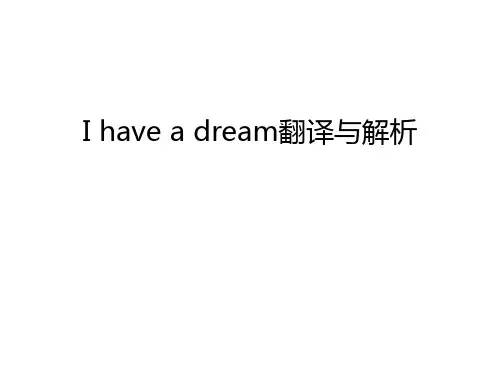
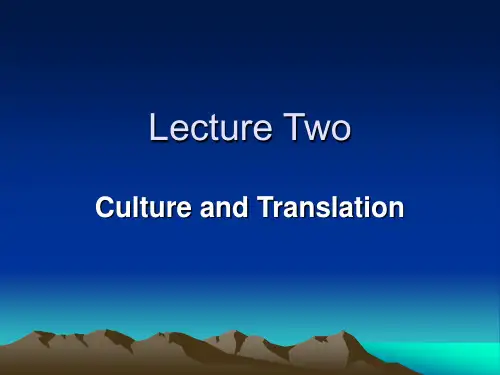
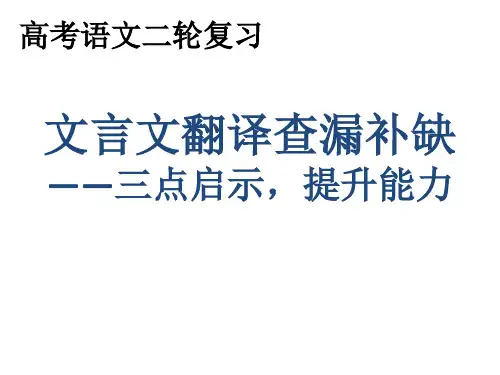
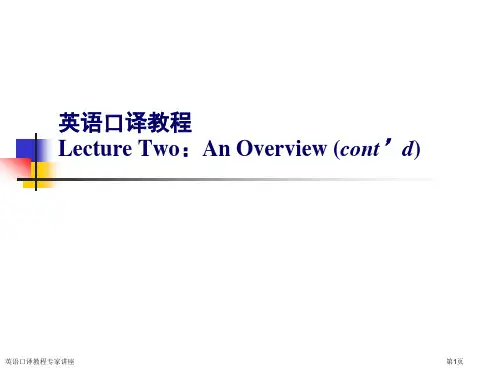
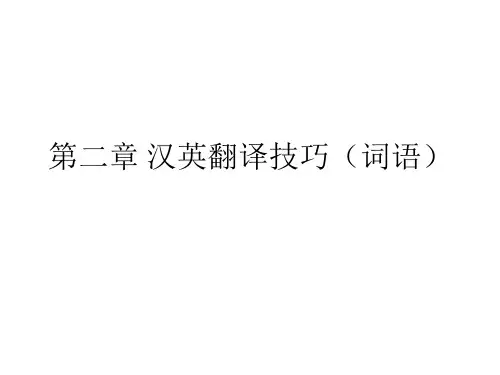
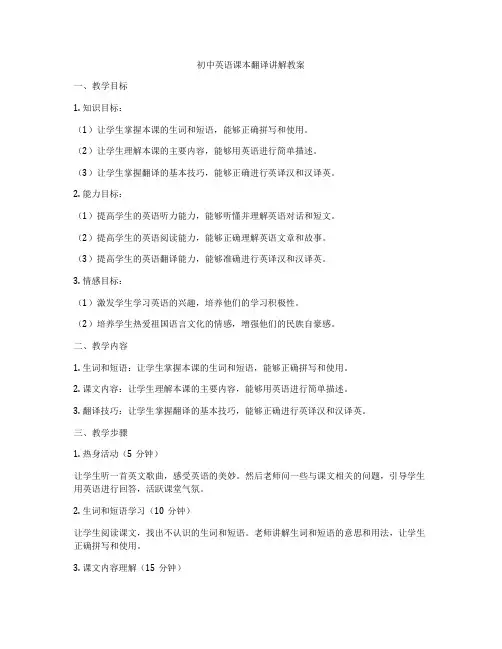
初中英语课本翻译讲解教案一、教学目标1. 知识目标:(1)让学生掌握本课的生词和短语,能够正确拼写和使用。
(2)让学生理解本课的主要内容,能够用英语进行简单描述。
(3)让学生掌握翻译的基本技巧,能够正确进行英译汉和汉译英。
2. 能力目标:(1)提高学生的英语听力能力,能够听懂并理解英语对话和短文。
(2)提高学生的英语阅读能力,能够正确理解英语文章和故事。
(3)提高学生的英语翻译能力,能够准确进行英译汉和汉译英。
3. 情感目标:(1)激发学生学习英语的兴趣,培养他们的学习积极性。
(2)培养学生热爱祖国语言文化的情感,增强他们的民族自豪感。
二、教学内容1. 生词和短语:让学生掌握本课的生词和短语,能够正确拼写和使用。
2. 课文内容:让学生理解本课的主要内容,能够用英语进行简单描述。
3. 翻译技巧:让学生掌握翻译的基本技巧,能够正确进行英译汉和汉译英。
三、教学步骤1. 热身活动(5分钟)让学生听一首英文歌曲,感受英语的美妙。
然后老师问一些与课文相关的问题,引导学生用英语进行回答,活跃课堂气氛。
2. 生词和短语学习(10分钟)让学生阅读课文,找出不认识的生词和短语。
老师讲解生词和短语的意思和用法,让学生正确拼写和使用。
3. 课文内容理解(15分钟)让学生阅读课文,理解课文的主要内容。
老师提问,学生用英语进行回答。
老师讲解课文中的难点和重点,帮助学生更好地理解课文。
4. 翻译技巧讲解(10分钟)老师讲解翻译的基本技巧,如直译、意译、对译等。
老师给出一些例子,让学生进行练习。
5. 翻译练习(10分钟)让学生进行英译汉和汉译英的练习。
老师给出一些句子或段落,学生进行翻译。
老师对学生的翻译进行指导和纠正。
6. 总结和作业布置(5分钟)老师对本节课的内容进行总结,强调重点和难点。
布置作业,让学生进行巩固练习。
四、教学评价1. 课堂参与度:观察学生在课堂上的发言和表现,评价他们的学习积极性。
2. 生词和短语掌握情况:检查学生的单词和短语拼写和运用情况,评价他们对生词和短语的掌握程度。
汉英翻译讲座(2)汉英翻译讲授人:高雷第一讲英语,你美在哪里?1 音美1.1 音韵《汉英双语现代汉语词典》对“音韵”有如下解释:(1)和谐的声音、诗文的节韵律(harmonious sound; syllabic rhyme and rhythm)(2)汉字字音的声、韵、调(sound, rhyme and tone of a Chinese character)1. His words are always more candied than candid.2. Reckless drivers cannot be wreckless drivers.1.他的甜言蜜语多于诚恳。
2.司机粗心必出事故1.2 头韵头韵是一种辅音相同现象,即两个以上的词的词首辅音相同。
并列的一些词的任何一个音节中的辅音相同也是头韵的一种,这种在词中间的辅音相同叫内头韵或暗头韵。
头韵是英语所特有的,不仅见于诗歌(头韵诗)中,而且见于散文中,也常见于成语中。
它给语言增添了一种音韵美,使文字富有音乐感,便于朗读、记忆。
有时它还有强化语势或使语句听起来诙谐、俏皮等作用。
1. Let sleeping dogs lie.2. Money makes the mare go.3. Accident: car, caress, careless and carless.1.让狗静卧。
(别惹是生非)2.有钱能使鬼推磨。
3.飞来横祸:驾车上路、卿卿我我、马马乎乎、汽车没了。
4. Penny wise and pound foolish.5. Scientists See Planet outside Solar System6.三十岁之后,看见破旧肮脏的的士都心烦。
4.小事聪明,大事糊涂。
5.天文学家观察到天外有天。
(太阳系以外的行星)6. After thirty, even the sight of a shabby and sordid taxi may sicken me.1.3 腹韵腹韵(assonance)(亦称“元韵”或“准押韵”)指谐音或发音相似,尤指词中元音的相似。